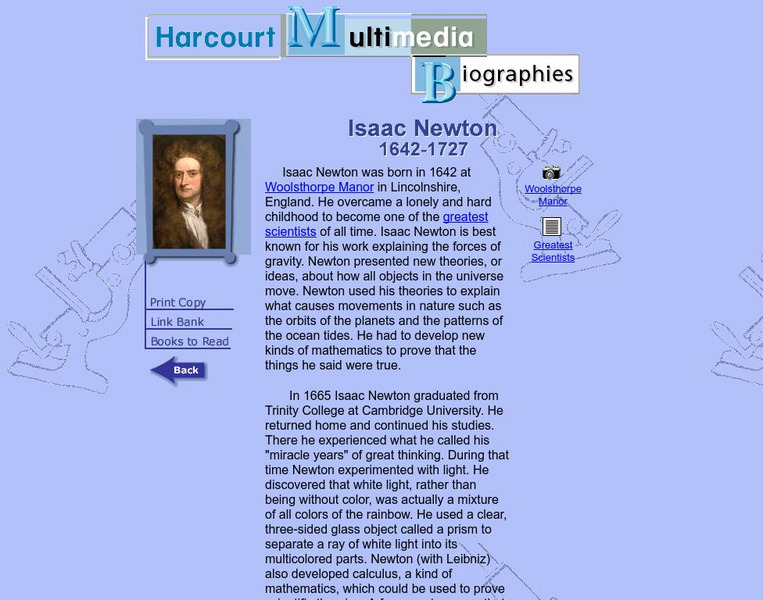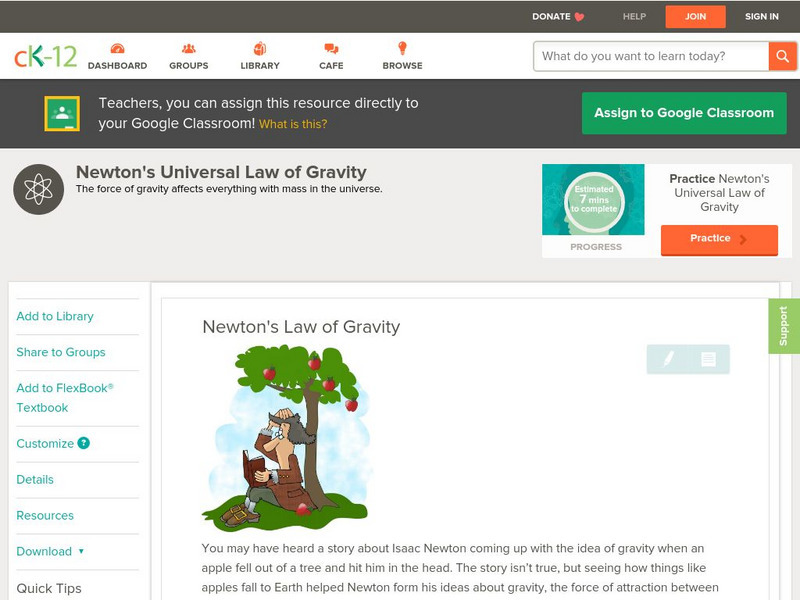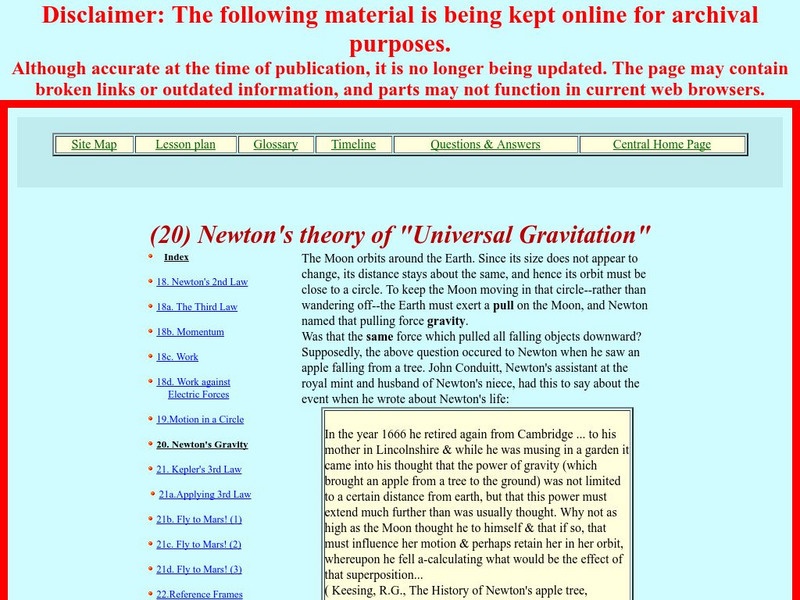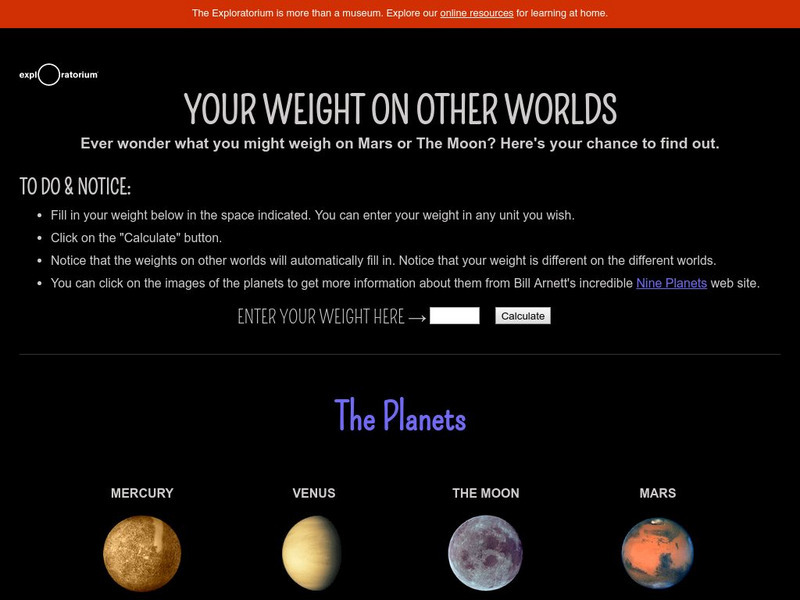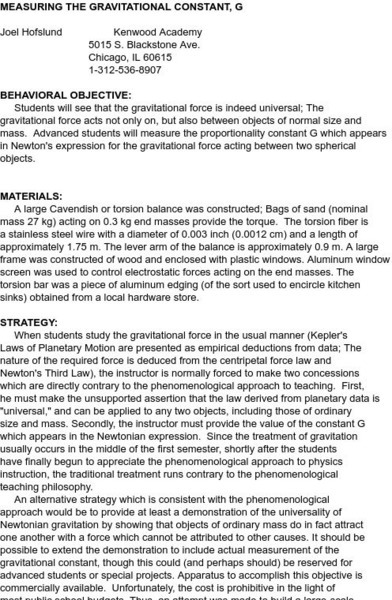Hi, what do you want to do?
University of Virginia
Sir Isaac Newton Projectiles and Planets
A short account of Newton's life is provided (from birth to death) as is a somewhat detailed look at Newton's studies of gravity.
Other
Isaac Newton
A page at the Isaac Newton (1642-1727 CE) Institute for the Mathematical Sciences website. This page, the contents of which come from the Microsoft Encarta encyclopedia, describes the upbringing, the education, the scientific and...
Read Works
Read Works: Famous Scientists Sir Isaac Newton
[Free Registration/Login Required] This passage is a short biography of Sir Isaac Newton and his discovery of the force of gravity. This passage is a stand-alone curricular piece that reinforces essential reading skills and strategies...
Khan Academy
Khan Academy: Isaac Newton
A biography of the scientist that developed the theory of gravity and founded the three basic laws of motion, Isaac Newton.
Houghton Mifflin Harcourt
Harcourt: Biographies: Isaac Newton
A brief biography on scientist Isaac Newton, highlighting his discoveries and the book he published in 1687, "Principia", which was on his theories of gravity and laws of motion.
University of St. Andrews (UK)
University of St. Andrews: Isaac Newton (1643 1727)
This life of Isaac Newton' traces his life from birth through childhood to his rise as a renown scientist and mathematician.
Vision Learning
Visionlearning: Mechanics: Gravity: Newtonian Relationships
Explanation of how astronomers and scientist developed the current theories of gravity.
Ducksters
Ducksters: Biography for Kids: Scientist: Isaac Newton
Investigate Isaac Newton's biography on this site. Learn how he was a scientist who discovered gravity, the three laws of motion, and calculus. He is considered one of the great scientists in history.
CK-12 Foundation
Ck 12: Physical Science: Newton's Law of Gravity
[Free Registration/Login may be required to access all resource tools.] Newton's law of universal gravitation and factors that affect the strength of gravity between two objects.
PBS
Pbs Learning Media: Newton's Third Law: Action Reaction
An early astronaut's experiences teach students that Newton's third law of motion-for every action, there is an equal and opposite reaction-applies both on Earth and in outer space.
Physics Classroom
The Physics Classroom: Circular and Satellite Motion: The Inverse Square Law
Through illustrated examples and interactive practice, students explore Newton's ability to relate the cause for heavenly motion (the orbit of the moon about the earth) to the cause for Earthly motion (the falling of an apple to the...
Physics Classroom
The Physics Classroom: The Apple, the Moon, and the Inverse Square Law
Describes the logic behind the development of Newton's law of universal gravitation. Beginning with Johannes Kepler and his three laws of planetary motion, content walks the reader through Newton's thought process and development of this...
NASA
Nasa: Newton's Theory of "Universal Gravitation"
This site, which is provided for by NASA, discusses the thinking which led Newton to understand universal gravitation.
Physics Classroom
The Physics Classroom: Newton's Law of Universal Gravitation
States the equation of Newton's law of universal gravitation. States the value of G and uses the equation to solve problems.
Discovery Education
Discovery Education: Physical Science: Gravity Gets You Down
In this lesson, students make predictions about falling objects of different sizes and masses to learn about gravity and air resistance. Includes audio vocabulary list and extension activities.
Exploratorium
Exploratorium: Your Weight on Other Worlds
From the Exploratorium Museum. Includes an interactive feature in which a visitor enters their weight on earth and has their weight on other planets computed and displayed. Discusses the distinction between mass and weight and describes...
Science4Fun
Science4 Fun: Gravity
Peruse this resource to learn about gravity, its importance, the Universal Law of Gravitation, the difference between mass and weight, and more fun facts.
Physics Classroom
The Physics Classroom: Cavendish and the Value of G
A short description of how Cavendish measured the value of G - the universal gravitation constant and supported Newton's theory. Illustrated.
Soft Schools
Soft Schools: Physics Quizzes: Newton's Three Laws
Assess your understanding of Newton's three laws of motion and the ability to distinguish between the three with this interactive multiple choice quiz. Receive immediate feedback to your answers.
Curated OER
Educational Technology Clearinghouse: Clip Art Etc: Sir Isaac Newton
(1642-1727) English natural philosopher, mathematician, and physicist most famous for gravity and his laws of motion.
Science and Mathematics Initiative for Learning Enhancement (SMILE)
Smile: Measuring the Gravitational Constant, G
A demonstration/lab idea for determining the numerical value of the universal gravitation constant using a torsion balance.









